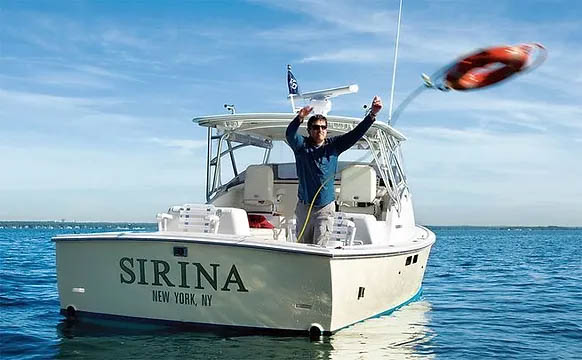This is one of those articles that may not be fun to read, but could well save a life one day. Because water is involved in every type of boating, every boater should understand as much as they can about drowning. As the expression goes: “the life you save may be your own.”
A member of your family may fall while waterskiing. A friend may trip and fall overboard while fishing. A visitor may slip into the lake while boarding your boat. In these common scenarios and many more like them, drowning is always a possibility. To be prepared and to avoid disastrous results from such scenarios, take a minute to understand the following. Current research breaks down drowning emergencies into two types: Aquatic Distress and Instinctive Active Drowning Response.
With Aquatic Distress, the victim will be noticeably struggling and may even call for help. These victims are able to assist in their rescue by grabbing a lifeline or your boat. Victims in the process of drowning from Aquatic Distress often have their eyes closed and head tilted back. They will be gasping for air but not making any progress with their efforts to swim.
With Instinctive Active Drowning Response, there is very little splashing and no calls for help. People are drowning, but do not look like it. Victims are unable to call out for help because their breathing efforts take priority over speech. They use their arms instinctively to keep themselves upright rather than waving for help. With this type of quiet drowning you should always ask if they are okay (for example, when a water skier falls). If they don’t answer, rescuers typically only have about 30 to 60 seconds to recover the victim before they submerge.
Current research has provided us with new information as to what to expect and how to survive should a water dunking place you in trouble. Falling into cold water provokes a ‘gasp reflex.’ It is likely that you will inhale water and sink underwater, and if you are not wearing a life jacket it’s unlikely you will resurface. The initial shock factor causes panic, hyperventilation, and an increased heart rate. You will need to focus on staying afloat during these first two to three minutes. After only a few minutes in cold water, you will experience the loss of basic motor skills. Depending upon the temperature of the water, your arms will quickly lose both strength and muscle co-ordination and you will completely lose the ability to swim. Control your breathing and hold onto something, staying as still as possible. It is not recommended that you attempt to swim to safety.
Apparently victims can survive in water for longer periods than originally estimated, but if the water is very cold, hypothermia will set in quickly regardless of your body type, or insulated clothing and your core body temperature will become dangerously low. In very cold water, most victims go unconscious in less than the first 30 minutes of emersion unless they have something to hold onto. When and if you are rescued, proper medical attention is essential to warm up your body safely.
Let’s look at the boater’s checklist that should be followed in a situation where, while driving a boat, you encounter a person at risk in the water.
1) Someone Call Out Loud:
The first person in the boat to spot trouble in the water must call out the problem. For example, “skier down and struggling,” “man overboard,” etc.
2) Point to the Victim:
The person that spotted the victim must point them out and continuously maintain sight until the victim is in hand. This gives the boat driver ongoing position reference.
3) Drive to the Victim:
The driver, using the pointers arm as reference, will slow to a speed that makes no wake, turn towards the victim, and follow a pattern that approaches the victim from downwind to upwind. Note: jumping in after someone drowning is not recommended.
4) Prepare Rescue Tools
Either a third person or the pointer will assemble the safety items in the boat that they will use to secure the victim. If the victim is in ‘aquatic distress,’ a throwable device should be tossed.
5) Maneuver the Boat Alongside the Victim:
The driver must be capable of bringing the boat close enough alongside the victim that others in the boat can grab hold of the victim (either by hand or with a boat hook).
Note: At this point the driver must have the engine in neutral or shut off to prevent an accident with the propeller.
6) Help Victim into the Boat:
Once alongside, the persons in the boat can help bring the victim aboard.
7) Assess the Victim:
Hopefully the victim will be conscious and begin to cough. If not, and there is no pulse, apply CPR immediately, call 911 and keep applying CPR. Ask the paramedics to go to a shoreline meeting point destination that is familiar to both yourself and the paramedics.
Knowing more about drowning symptoms and conducting these practice drills with your family will greatly reduce your chances of encountering a drowning tragedy. And isn’t that what we all want?





